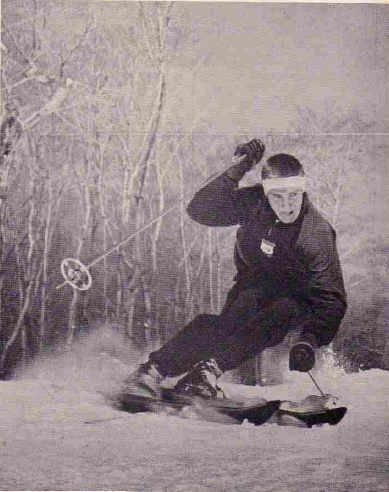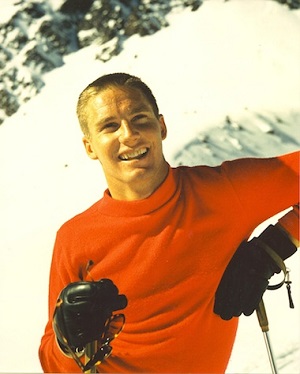In March of 1955 the Mount Mansfield Ski Club hosted the second American International Ski Races at Stowe. The event attracted some of the top European racers with 25 of the 100 competitors coming from outside the United States. For the American competitors the races carried extra meaning since they were one of two events that would determine the 1956 US Olympic Team. On the women’s side, Andrea Mead Lawrence would win both the slalom and GS and tie for first in the downhill demonstrating that she would be ready to defend her 1952 gold medals.
 Austrian Anderl Molterer would win both slalom and GS for the men. The third race for the men was the downhill staged on the Nose Dive which still had its famous seven turns. The pre-race favorite was Martin Strolz of Austria who had finished second in the downhill at the World Championships the previous year. However a 19-year-old from Steamboat Springs, Colorado, would serve notice that he would be an American contender on the international ski scene. Wallace “Buddy” Werner won the downhill beating Strolz by 4.7 seconds and beating the previous record time by 9.2 seconds.
Austrian Anderl Molterer would win both slalom and GS for the men. The third race for the men was the downhill staged on the Nose Dive which still had its famous seven turns. The pre-race favorite was Martin Strolz of Austria who had finished second in the downhill at the World Championships the previous year. However a 19-year-old from Steamboat Springs, Colorado, would serve notice that he would be an American contender on the international ski scene. Wallace “Buddy” Werner won the downhill beating Strolz by 4.7 seconds and beating the previous record time by 9.2 seconds.
Werner would make the 1956 Olympic team and have very respectable if not winning performances finishing 11th in the GS and 21st in the downhill. In 1958 at the World Championships he would have a fourth place in slalom and fifth in GS. By then he had gained fans in Europe due to his go-for-broke style. Billy Kidd says of Werner “Buddy was one of the few Americans that could beat the Europeans and do it not just once and awhile by luck, but often enough so that the Europeans really loved him. They loved his style of going for it and taking chances.”
In 1959 Werner would become the first non-European to win the Hahnenkamm downhill. The only other US skier to achieve that would be Daron Rahlves in 2003 – and that was on a shortened course due to fog!
Werner was a favorite to win the first Olympic medal for an American male at the 1960 Squaw Valley Olympics. But eight weeks before the Olympics he broke his leg during training and missed possibly his best chance for Olympic fame. Sports Illustrated titled their article about Buddy Werner “The Man with No Luck.”
The 1964 Innsbruck Olympics would be Werner’s last chance to win a medal since he had announced his planned retirement from ski racing at the end of the season.
 Bob McKee was the first to correctly identify Buddy Werner as the Olympic skier from Steamboat Springs. Bob was in Innsbruck for the 1964 Winter Olympics and actually attended the US-Finland hockey game with Buddy Werner. Bob says that Werner was one of those rare people who was an intense competitor, but still a nice guy that everyone liked. Even the Europeans were rooting for Werner to win a medal. Werner placed 17th in the downhill and then DSQed in the GS. Bob was watching from the bottom of the slalom course to see Pepi Stiegler, Billy Kidd, and Jimmy Heuga take the gold, silver, and bronze while Werner finished 8th. Despite that disappointment, Werner was the first to embrace and congratulate his young protégés, Kidd and Heuga, on their medal results.
Bob McKee was the first to correctly identify Buddy Werner as the Olympic skier from Steamboat Springs. Bob was in Innsbruck for the 1964 Winter Olympics and actually attended the US-Finland hockey game with Buddy Werner. Bob says that Werner was one of those rare people who was an intense competitor, but still a nice guy that everyone liked. Even the Europeans were rooting for Werner to win a medal. Werner placed 17th in the downhill and then DSQed in the GS. Bob was watching from the bottom of the slalom course to see Pepi Stiegler, Billy Kidd, and Jimmy Heuga take the gold, silver, and bronze while Werner finished 8th. Despite that disappointment, Werner was the first to embrace and congratulate his young protégés, Kidd and Heuga, on their medal results.
After the 1964 racing season ended, Willy Bogner recruited Werner for a big-time ski movie he was making called “Ski-Fascination”. On April 12, 1964 Bogner, Werner, and German Olympic medalist Barbi Henneberger were skiing and filming near St. Moritz. They were on their second run on a particular slope when it avalanched. The legend has it that Werner and Henneberger out-skied the first avalanche only to be caught in a second one where both Werner and Henneberger died.
Werner’s hometown of Steamboat Springs renamed the primary ski mountain at Steamboat from Storm Mountain to Mount Werner. If you ski there, you’ll find a run named after him, Buddy’s Run, and in the town the Buddy Werner Memorial Library which was established from world-wide donations.

February 6, 2014 at 6:46 pm
Pretty sure Martin Strolz was from Austria, not Germany. My recollection is he was from Lech am alberg.
November 26, 2016 at 10:25 am
Excellent post, i did read it twice so sorry for this, i have passed it
on to my friends, so with any luck they may like it as well.
April 2, 2017 at 9:39 am
Brilliant Piece of writing